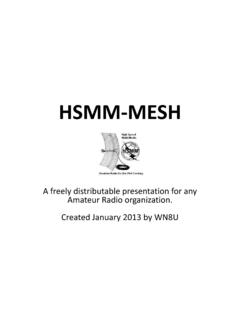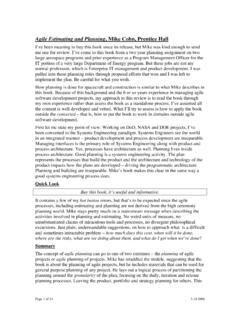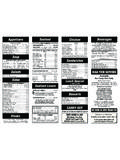Transcription of BY KD8OUT, Mike Kieffer
1 BY KD8 OUT, mike KiefferHOW WOULD YOU LIKE TO SHORTEN YOUR DIPOLE TO FIT YOUR YARD? There are six ways to shorten your wave dipole Tuned feeders Matching at the dipole feed point Loading coil to tune out the capacitive reactance Linear Loading Capacitive end loading Combining some of the above We are going to use an 80 meter wave dipole for this discussion. An 80 meter dipole ( ) is about meters ( )total length. TUNED FEEDER In a typical wave dipole center fed by ladder line is approx. 13 -j 1100 used on 80 meters. j1100 is right at the upper limit of a typical LDG transmatch (tuner), so you could step it down with a balun transformer before the transmatch. MATCHING AT THE DIPOLE FEED POINT A matching network (transmatch) could be installed at the feed point, but this is impractical for a dipole.
2 This can be done with a base fed vertical antenna, but is not feasible for an elevated dipole. COIL LOADING Loading coils can be installed anywhere along each leg of the shortened dipole. The further out on the leg the coil goes, you a higher radiation resistance (good), but requires a larger coil and higher resistive loss (bad). Therefore, as you move the coil toward the end, there is a balancing of competing efficiencies. DJ4AX did a series of experiments moving the loading coil from center to end. He found that the position did not matter in practice. Use the highest Q loading coils is most important. Larger diameter, flat wire, silver plate. LINEAR LOADING (65 FEET) is the wave length of a 40 meter dipole. CAPACTIVE (end) LOADING It has the advantage 0f physically shortening the antenna, without introducing inductor losses!
3 THE MAGIC BULLET. Lets see: S= (2286cm) full length is meters D= 12ga wire H=10 meters (1000cm) Z (impedance) = 1093 A wave dipole equals 180 degrees of a wave, so each leg equals 90 degrees. The S= meters is about a 45% shortening ratio of the wave length ( ). Therefore 90 x ( ) = degrees X (inductive) = j x 1093 x tan( ) = 1550 You need j 1550 to cancel the X above C = 1,000,000 / (2 x x x 1550) = 27pf Diameter of hat = x 27 = 77 cm or Bingo Bango D= (see chart on next slide) x 27 pf = 77 cm ( ) capacitive hat (disc) on each end of the dipole. The formula above is for a solid disc, an 8 spoke disc is a good approximation. So for (75feet) dipole, 10m off ground, a 30 hat at each end will resonate the dipole at !
4 This graph represents capacitance hat diameter vsCapacitance in pf








